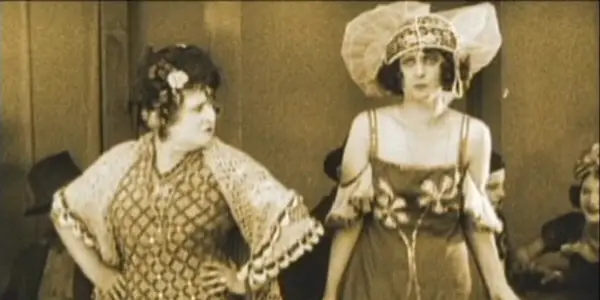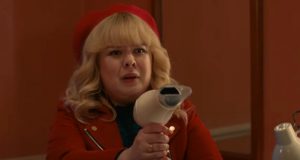
Welcome to A Century in Cinema, the monthly column where I’ll be discussing films from a hundred years ago, the historical impact they had, and how they hold up today. Whether we’re covering timeless classics or obscure gems, follow along as we continue to explore…a century in cinema! WARNING: Hundred-Year-Old SPOILERS ahead!
While we love film in all shapes and formats, we hold a special place in our hearts for independent films, especially those created by filmmakers in minority groups. To that end, when given the opportunity to write about an independent film starring and written, produced, and directed by a woman in 1923 — an era not exactly known for their progressive views of gender roles — we don’t pass it up. The Grub Stake, a lesser-known gem of feminism both in front of and behind the camera, is a wonderful example of a woman and her uncompromising vision.
A Foolish Leap of Faith
We’re introduced to our heroine Faith (Nell Shipman), a model and clerk in a Seattle art studio. In the middle of a session, Mark Leroy (Alfred Allen) enters to buy supplies, and in pulling them off of the shelf, Faith falls and loses the blanket covering her up. At that moment, the owner of the shop comes in, and after rectifying the situation, he stiffs her pay for another week. She protests, needing medicine for her father, but she’s fired instead.
Desperate for money, she sells some of her long hair at a barber shop. As she leaves, donning a large hat to hide her lesser locks, she runs into Leroy, who offers to pay her to model for a line of posters for a hair tonic, since he loves her hair so much. Talk about a lack of timing. The next day, she shows up at his place, revealing what she’s done to her hair and apologizes for being unable to pose for him. He confesses that he was bluffing about selling hair tonic, and just wanted an excuse to invite her over.
After some drinks, she expresses her wish to travel up to Alaska with her father, who she calls Skipper, and try for a fresh start. She asks Leroy for a loan to start her laundry business for the miners up there, which he deems a “grub stake.” For her trouble, he forces himself on her, but she fights back and leaves as penniless as she came. Back home, Faith is devastated, but Skipper (Walt Whitman, but not that one), who only speaks nautically, tries to keep the faith. Just then, she’s delivered a mound of packages by Leroy’s trusted associate (Ah Wing), all the clothing she’ll need to travel north, and Leroy agrees to be partners for real.
source: Nell Shipman Productions
As Faith and Leroy travel by boat along with her father, he proposes, which she happily accepts, but he warns her they must keep their engagement secret for a while. To celebrate, they honeymoon over Dawson Trail in Canada, where they guide dog sleds into town. That night, Leroy provides her with a lavish dress for a party, the likes of which she’s never attended, at a dance hall. There, she meets the hard-boiled Dawson Kate (Lillian Leighton) and Malamute Mike (George Berrell), an old, alcoholic miner who laments to anyone who will listen about the lost gold mine he found, but can’t remember its location. He’s tossed from the party, and Dawson Kate informs her that Leroy has repeatedly brought women here from elsewhere and shows her a photo of his actual wife.
Upset, Faith leaves, only to overhear Leroy’s conversation as he negotiates her price and jokes about her father’s imminent death. She races home, where Skipper is about to be poisoned by Leroy’s associate. Malamute Mike barges in, upset that Skipper stopped playing his accordion to take a drink, and swipes the glass just as Faith arrives to save them both. As the associate runs off to warn Leroy, Mike leads Faith and Skipper into the wilderness to hide, as repayment for saving his life, and to find that mine.
A Fabulous Film, Though Not Without Faults
The film continues as a thrilling adventure drama, with both moments of high tension and idyllic montages of Faith relishing the beauty of the nature she so desperately longed for. One scene in particular, where she’s visited in the meadow by all kinds of forest creatures, so vividly recalls that of Snow White that I would almost bet Walt Disney saw this and was inspired. Almost. Tragically, Shipman’s distributor fell through due to bankruptcy, so this never got a theatrical release. Luckily, this and her other films, as well as photos and other documents, have been preserved within the Boise State University archives.
The Grub Stake was made by Shipman’s own production company, the second one she co-founded after Shipman-Curwood Producing Company, which came to being after she turned down an acting contract from Samuel Goldwyn. This one, Nell Shipman Productions, was created with her partner Bert Van Tuyle, the co-director of this picture with whom she had a six-year-long affair while she was married. They separated during filming, reportedly due to his deteriorating mental state, and this was her final feature film.
source: Nell Shipman Productions
During the winter of 1922-23, Shipman traveled to Priest Lake, Idaho, where she set up a film camp called Lionhead Lodge. There, she filmed Grub Stake as well as others. An animal lover and animal rights activist, she owned a personal zoo of over 200 animals, which she transported up to the lodge and some of which are featured in the film and make for some incredible shots. Given her passion for nature, she was known to frequently shoot outdoors and became one of the first directors to shoot entirely on location. What’s most impressive about this film is these nature shots, with bears, beavers, and so much more clearly in frame with Shipman and no photographic trickery. In addition, story-wise, having two strong women as leads is thrilling, though Faith does have some moments as the pure, naïve damsel.
What might be hard to endure, especially for modern viewers, is the depiction of Leroy’s associate. Never given a name, though curiously called John at one point by Faith, he is the embodiment of so many stereotypes regarding Chinese people. Depicted as only villainous, treated as lesser than, and only dressed in stereotypical clothing, it’s surprising that they even casted an actual Chinese person in the role. Despite one interaction with Faith where he speaks Chinese and we’re shown a very ignorant title card that amounts to “HUH?!,” even when he speaks to Leroy, it’s written out in a way that is so stereotypical it’s almost cliché. They could have honestly taken away all of this, and just had a normal, non-racist character, and it literally would not have changed the film in the slightest.
The Grub Stake: Conclusion
The Grub Stake is an adventure-romance that can be enjoyed by both nature lovers and drama junkies alike. Though the story has its share of coincidences, it’s still enjoyable, and is reminiscent of contemporary adventure serials, with tight plots to ensure the story keeps chugging along. While perhaps not as independent as the heroine of The Smiling Madame Beudet, Faith is still a strong character with her own ambitions, and she’s willing to fight for them even if she happens to fall in love on the way. Despite being made outside of the Hollywood system, Nell Shipman is a pioneer for women in film, who should be an inspiration to independent filmmakers and ought to have her name spoken in the same breath as Dorothy Arzner.
Does content like this matter to you?
Become a Member and support film journalism. Unlock access to all of Film Inquiry`s great articles. Join a community of like-minded readers who are passionate about cinema – get access to our private members Network, give back to independent filmmakers, and more.





